|
Having trouble reading this email?
Download the PDF.

IN THIS ISSUE
 |
Oil palm plantations: threats and opportunities for tropical ecosystems
An international commodity used for food, household and industrial purposes, oil palm is cultivated on approximately 15 million ha
worldwide. As global demand for palm oil is expected to double by 2020, researchers have broadly studied the varying environmental
threats arising from increased oil palm production.
|
Thematic Focus: Ecosystem Management and Resource Efficiency
Why is this issue important?
Oil palm (Elaeis guineensis) is cultivated on approximately 15 million ha across the world (FAO 2009, Fitzherber and others 2008;
Koh and Ghazoul 2008; Koh and Wilcove 2008a). The extracted palm oil is used in many food and household products as well as biodiesel
production. Increases in global demand for food and fuel are driving forest clearance in the tropics, a significant portion of which
is due to the rapid expansion of oil palm monocropping (Figure 1). Tropical forest is considered the most diverse terrestrial
ecosystem (Corley and Tinker, 2003), and provides important ecosystem goods and services such as containment of large carbon
stocks—an essential function in climate change mitigation (Bala and others 2007; Lapola and others 2010).
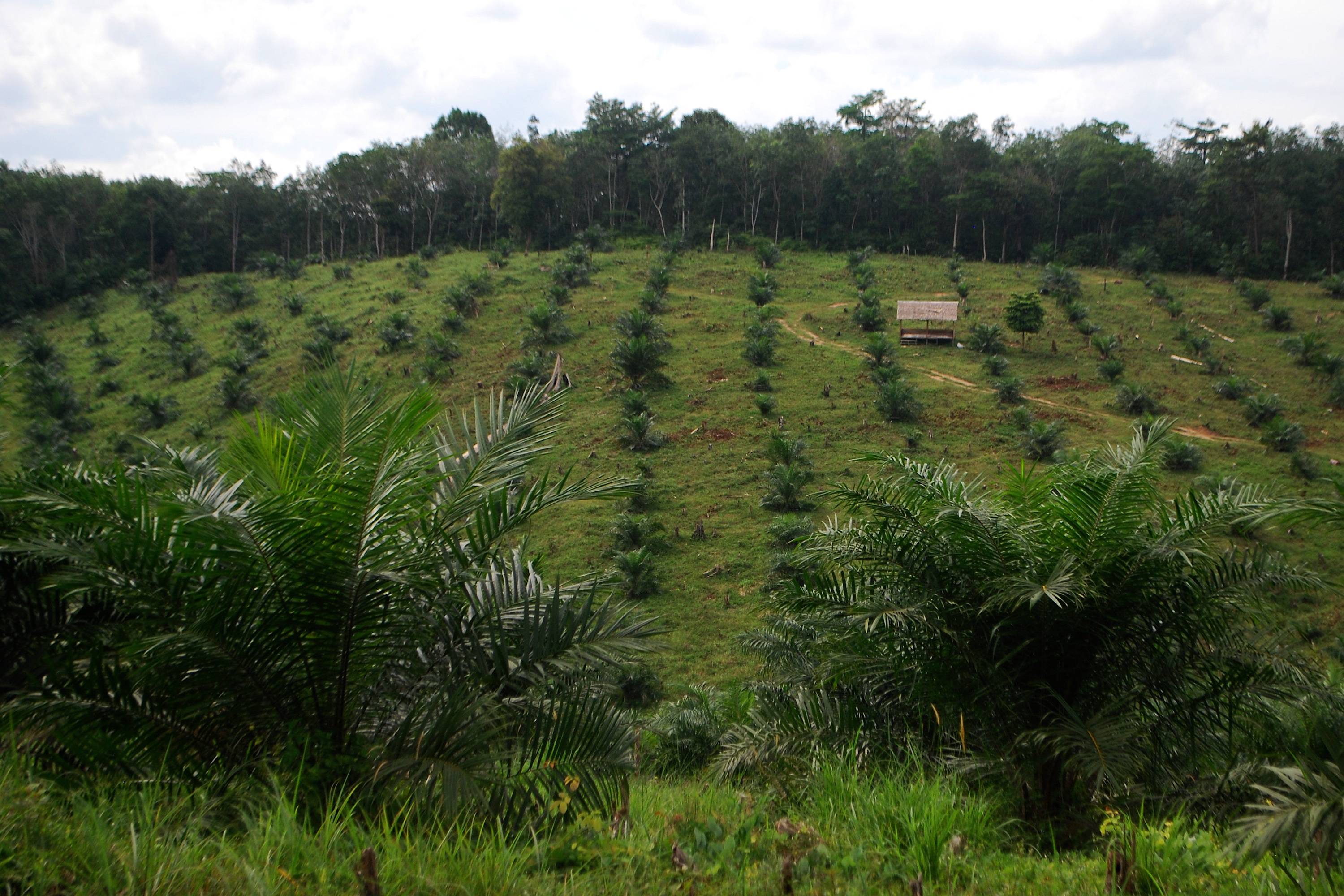
Figure 1. Part of an oil palm plantation at the border of intact forest. Jambi, Indonesia, December 2010. Photo by Iddy Farmer/CIFOR
Oil palm: economic importance
The oil palm provides one of the leading vegetable oils produced globally, accounting for one-quarter of global consumption and approximately 60
per cent of international trade in vegetable oils (World Bank 2010). The oil extracted from these palms is included in several common products used
all over the world such as margarine, baked goods and sweets, detergents and cosmetics (UNEP and UNESCO 2007). An estimated 74 per cent of global palm
oil usage is for food products and 24 per cent is for industrial purposes (USDA 2010). Since the 1990s, the area occupied by oil palm cultivation has
expanded worldwide by around 43 per cent, driven mainly by demand from India, China and the European Union (RSPO 2011; Figure 2).

Full Size Image
Figure 2. Top ten palm oil producers, importers and consumers at a global scale.
Biodiesel from oil palms
Oil palm is among the most productive and profitable of tropical crops for biofuel production. High-yielding oil palm varieties developed by
breeding programmes can produce over 20 tonnes of fresh fruit bunches/ha/yr under ideal management, which is equivalent to 5 tonnes oil/ha/year
(excluding the palm kernel oil) (FAO 2002) (Figure 3). The oils form 10 per cent of the total dry biomass produced by the palm, but the 90 per cent
left might be a source of fibre and cellulosic material for second-generation biofuel production (Basiron 2005). Production of biodiesel from oil
palm has been increasing in recent years, particularly in Africa and Latin America (FAO 2010; Mitchell 2011).

Full Size Image
Figure 3. Oil palm is considered one of the highest yielding mass market oil seeds for first
generation biofuels. Source: Lester 2006
Oil palm distribution
Oil palms are restricted to the tropics and have mainly been cultivated in Indonesia, Malaysia and Thailand in Southeast Asia, Nigeria
in Africa, Colombia and Ecuador in South America and Papua New Guinea in Oceania (FAO 2009) (Figure 4). Global demand for palm oil is
expected to double by 2020. Assessments to determine suitable locations for new oil palm plantations are ongoing (Figures 4 and 8). New
plantations continue to be established and existing ones are being expanded (WWF 2011a). Environmental threats due to the effects of oil
palm plantations have been broadly studied in Asia, mainly in Indonesia and Malaysia, where 85 per cent of global production is taking place.

Full Size Image
Figure 4. Surface cultivated and estimated tropical forested area suitable for oil palm plantations.
Major Findings and Implications
Oil palm monoculture and its effects
Traditionally, oil palm production was managed as part of mixed farming practice in West Africa. Today, most production is being
expanded as an industrial-scale mono-crop, imposing significant environmental risks as well as impacts on local societies, particularly for
people with limited economic capacities (Colchester 2010).
Modern oil palm cultivation is generally characterized by large monocultures of uniform age structure, low canopy, sparse undergrowth, a
low-stability microclimate and intensive use of fertilizers and pesticides (Fitzherbert and others 2008). The oil palm tree generates fruits
from the third year, with yield per tree increasing gradually until it peaks at approximately 20 years (FAO 2002). Hence, oil palm plantations
are typically destroyed and replanted at 25 to 30 year intervals (Wahid and others 2005).
The process of palm oil production tends to reduce freshwater and soil quality, and adversely affects local communities which are dependent on
ecosystem products (such as food and medicines) and ecosystem services (such as regulation of the hydrological cycle and soil protection)
provided by the forests (Fitzherbert and others 2008).
From an ecological point of view, oil palm monocultures might form impervious barriers to species' migration and result in greater susceptibility
to plant diseases. Conversion of natural forests increases habitat fragmentation and biodiversity loss. Abiotic edge effects include vulnerability
to wind, desiccation and occurrence of fires (Danielsen and others 2009).
Moreover, as oil palm plantations contain less biomass and have a shorter lifespan than natural forests, less carbon is sequestered. Drainage
of peatlands for conversion to plantations could also contribute significantly to greenhouse gas emissions, as further detailed below.
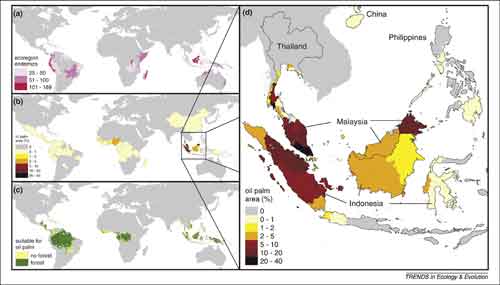
Full Size Image
Figure 5. Global distribution of oil palm and potential conflicts with biodiversity: (a) areas of high terrestrial
vertebrate endemism; (b) global distribution of oil palm cultivation; (c) agriculturally suitable areas for oil palm (with and without forest);
and (d) oil palm area in Southeast Asia. Source: Fitzherbert and others 2008
Social impacts
The worldwide market for palm oil is driving land acquisition in the form of large blocks of land, frequently linked with problems related
to tenure systems and land-use rights, resulting in the exploitation of local communities and frequent abuse of human rights (FPP 2011;
Colchester 2010). Palm oil seed cultivation and harvesting are predominantly performed by manual labour, creating one job for every 2.3 ha.
A major challenge is to implement regulations and procedures to address problems such as the inequalities between small-scale, often
informal producers, and large trans-national oil palm enterprises (Colchester 2010).
Socio-economic benefits of a sustainable oil palm plantation could include poverty alleviation and long-term employment opportunities.
Profit sharing may provide a further incentive, attracting more workers to the palm oil sector, along with better living and working
conditions (Albán and Cárdenas 2007). Depending on the role played by authorities and smallholder cooperatives, smallholders may
benefit substantially from oil palm production in Indonesia due to its higher returns to land and labour, compared to other commonly
grown agricultural products (Rist and others 2010). For instance, oil palm might be an alternative for farmers to invest in and
benefit from the higher returns they offer, instead of destroying forest for cattle pasture (Butler 2011a).
Status in Southeast Asia
According to UN reports, the establishment of oil palm plantations caused widespread forest destruction in Indonesia and Malaysia
(UNEP and UNESCO 2007) where the vast majority of the world's plantations are located. It is estimated that between 1990 and 2005,
55-60 per cent of oil palm expansion in the two countries occurred at the expense of virgin tropical forests (Koh and Wilcove 2008b;
WWF 2011a). By the early 2000s, 8.3 million ha of closed canopy oil-palm plantations were established in peninsular Malaysia. One-tenth
of that surface was established on peatlands (880 thousand ha or 6 per cent of total peatland area) (Figures 6 and 7). The peat swamp
clearance resulted in the loss of approximately 4.6 million grams (Mg) of carbon from peat oxidation. The loss of peat swamp forests
implies the loss of carbon sequestration service through peat accumulation, which amounts to approximately 660Â 000 Mg of carbon annually
(Koh and others 2011). By 2010, 2.3 million ha of peat swamp forests were clear-felled, and currently occur as degraded lands
(Koh and others 2011).
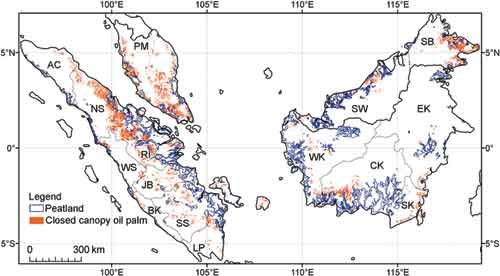
Full Size Image
Figure 6. Distribution of closed canopy oil palm plantations and tropical peatlands in the lowlands of Peninsular
Malaysia, Borneo and Sumatra (PM - Peninsular Malaysia; SW - Sarawak; SB - Sabah; WK - West Kalimantan; CK - Central Kalimantan; SK -
South Kalimantan; EK - East Kalimantan; AC - Aceh; NS - North Sumatra; RI - Riaus; WS - West Sumatra; JB - Jambi; BK - Bengkulu; SS -
South Sumatra; LO - Lampung). Source: Koh and others 2011
In addition to the loss of forest ecosystems, oil palm cultivation has also been accompanied by massive fires (especially during 1997/1998),
many of them started during land clearance and land preparation (IPOC/WWF 2004). Such fires cause health problems for the human population
and threaten biodiversity, including wildlife such as Asian elephants, Sumatran rhinos and Sumatran tigers, which are currently facing
extinction (WWF 2002). The survival of the orangutan in Southeast Asia is also of concern, as it faces grave threats to its habitat
including deforestation for oil palm development (UNEP and UNESCO 2007).
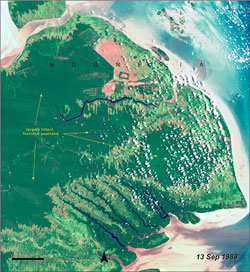
Full Size Image |
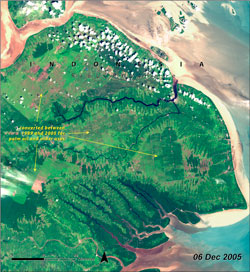
Full Size Image
|
|
Figure 7. Satellite images from the southeastern corner of Indonesia's Raui Province showing loss in tropical forest to
palm oil plantations between 1989 and 2005. The tropical forests are on peat formations up to 40 metres in depth (dark green = primary forest,
light green = palm plantations).
|
The example of the Brazilian Amazon
Brazil as a key country in the region
There are concerns that the expansion of oil palm cultivation could lead to deforestation in the Amazon region, given the history of
oil palm expansion in Southeast Asia (Butler 2011a). The Amazon contains about 40 per cent of the world's remaining tropical forest along
with its biodiversity and ecosystem services (Figure 8). Brazil has 29 million ha of land suitable for oil palm cultivation in the Amazon and
2.8 million ha outside of this region (Embrapa 2010). Particularly in the Brazilian Amazon, more carbon is stored in trees than in any other
country (47.9 billion tonnes in 3.3 million square kilometres) (Nepstad and others 2009). Biofuel production plays an important role in Brazil's
political objectives and economic development strategy, making its forest potentially more vulnerable (Laurance and others 2010).
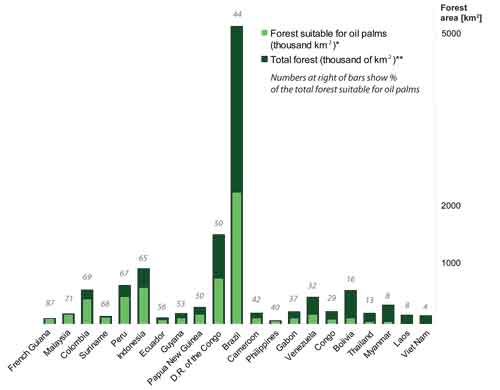
Full Size Image
Figure 8. Forest suitable for oil palms per country. Source: * Forest suitable for oil palms (Sickler and others 2007) ** Total forest (FAO 2010).
Potential expansion of plantations
Brazil currently produces 0.5 per cent of palm oil globally and envisions a 35 per cent expansion of sustainable oil palm production
(Embrapa 2010). The Brazilian Government has been promoting oil palm plantations under the Program for Sustainable Production of Palm Oil
since 2010, which seeks to limit expansion of oil palm cultivation to degraded land only. The current Brazilian administration is also
expected to keep a commitment made at the 2009 United Nations Climate Change Conference in Copenhagen to reduce deforestation by 80
per cent by 2020 (Tollefson 2011; Regalado 2011).
In May 2011, the Brazilian Chamber of Deputies approved a Forest Law Reform along with proposed changes that might support agribusiness,
risking an increase in deforestation rates (WWF 2011b). The reform offers amnesty from penalties for illegal cuts (up to 400 ha) made prior
to July 2008 to small landholders in the Amazon. It also modifies the rule requiring them to keep a minimum of 80 per cent forest cover
and allows the use of previously barred zones such as hilltops and slopes, and includes reducing the amount of forest that must be
preserved along the banks of streams and rivers.
Significant expansion of oil palm plantations is envisaged for the state of Pará, in the north of Brazil, by 2014. Figure 9 shows
established plantations and recently cleared forest area or young plantations in Mojû, a municipality of Pará.
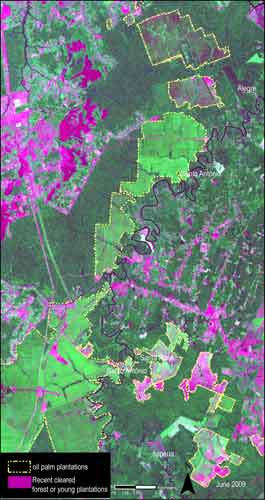
Full Size Image
Figure 9. Satellite image showing oil palm plantations in Mojû, Brazil. Source: Landsat 5 TM 2009
Towards sustainability
Determining factors
The environmental impacts of palm oil production and use can be assessed from a life-cycle point of view. This means carrying out a
holistic perspective in which emissions are taken into account, from the raw material extraction to the recycling or disposal stages.
Impacts depend greatly on the land-use change conditions, the consumption of conventional fuels, fertilizers, pesticides and the
wastes generated (Menichetti and Otto 2008).
The environmental sustainability of palm oil-based biodiesel production is determined by four factors: (1) land-use change; (2) soil
quality; (3) biodiversity and (4) water quality impacts (Stichnothe and Schuchardt, 2011). Land-use conversion from forest to oil palm
is perhaps the most important criterion when evaluating environmental sustainability with respect to greenhouse gas (GHG) emissions.
Degraded agricultural lands contribute to biodiversity loss, increased soil erosion, nutrient loss and GHG emissions. Notably, biodiesel
from palm oil that is used as a low-carbon alternative to gasoline often contributes far more GHG emissions to the atmosphere than it
is replacing when the plantations producing the palm oil were established by deforestation (Menichetti and Otto 2009; World Bank 2010).
Sustainability programmes and strategies
One safeguard to protect vulnerable communities from land tenure abuses has been the use of sustainable certification systems (RSPO 2007).
Entities worldwide including the European Commission and the World Bank are supporting the use and production of sustainable biofuels
authorized by certification bodies such as the Roundtable of Sustainable Palm Oil (RSPO) (FPP 2011; Mitchell 2011; Laurance and others 2010).
The RSPO is currently the most broadly recognized framework reference for sustainability in oil palm and defines standards for plantations,
including environmental and socio-economic aspects.
Other sustainability strategies include the REDD+ programme (Reducing Emissions from Deforestation and Forest Degradation) and the
POTICO (Palm Oil, Timber, Carbon Offset) project. The REDD+ is an instrument that creates a financial value for the carbon stored in
forests, offering incentives for developing countries to reduce emissions from forested lands and invest in low-carbon paths to sustainable
development. Under the POTICO project, firms agree to restrict sustainable oil palm expansion to already degraded lands (WRI 2011b).
Mapping and monitoring, supported by an appropriate regulatory framework are necessary to achieve sustainable management of oil palm
production. Analysis of spatial data, including from remote sensing, is a key tool to improve monitoring of legal and sustainable
plantations, especially when there are difficulties to access some areas.
It is necessary to protect the remaining tropical forests by designing new strategies that connect forest carbon and biofuel markets
in order to reduce GHG emissions, conserve biodiversity and promote economic growth in developing countries.
Acknowledgements
Written by: Lorena Segura Morana
Reviewed by: Ron Witta
UNEP/GRID-Genevaa
References
Albán M and Cárdenas H. 2007. Biofuels trade and sustainable development: the case of Ecuador's palm oil diesel. International Institute for Environment and Development. Ecuador. pp. 60
Bala G, Caldeira K, Wickett M and others 2007. Combined climate and carbon-cycle effects of large-scale deforestation. Proceedings of the National Academy of Sciences USA 104: 6550-6555
Basiron Y 2005. Biofuel: an alternative fuel in the Malaysian scenario. Malaysian palm oil board bulletin/palm oil developments, 32/Information Series, 2005
Butler R. 2011a. In Brazil, Palm Oil Plantations Could Help Preserve Amazon (http://e360.yale.edu/content/feature.msp?id=2415) (accessed 7 November 2011)
Colchester M 2010. Land acquisition, human rights violations and indigenous peoples on the palm oil frontier, Forest Peoples Programme and International Land Coalition. Moreton-in Mash UK
Corley R and Tinker P 2003. The Oil Palm. Wiley- Blackwell. 592 pp
Danielsen F, Beukema H, Burgess Parish F, Brühl CA, Donald, PF, Murdiyarso D, Phalan B, Reijnders L, Struebig M & Fitzherbert EM, 2009. Biofuel plantations on forested lands: double jeopardy for biodiversity and climate.
Conservation Biology 23: 348–358
Embrapa 2010. Dendê. Ministério da Agricultura, Pecuária e Abastecimiento. Brasil
FAO 2002. Small-Scale Palm oil processing in Africa. FAO Agricultural Services Bulletin 148 ISSN 1010-1365. Rome, Italy
FAO 2009. FAOSTAT online statistical service. Food and Agriculture Organization of the United Nations, Rome, Italy. Available via URL. http://faostat.fao.org/ (accessed August 2011)
FAO 2010. Global Forest Resources Assessment 2010, Food and Agriculture Organization of the United Nations. Rome, Italy.
Fitzherbert EB, Struebig MJ, Morel A, Danielsen F, BrĂĽhl CA, Donald PF & Phalan B 2008. How will oil palm expansion affect biodiversity? Trends in Ecology and Evolution 23(10): 539-545
FPP 2011. World Bank lifts suspension on financing palm oil. Forest Peoples Programme, England
IIASA 2002 International Institute for Applied Systems Analysis
IPOC/WWF- Indonesia. 2004. Impact Assessment on Oil Palm Development (Indonesia) by Dr Asril Darussamin, IPOC / Mr Fitrian Ardiansyah, WWF-Indonesia
Koh LP and Ghazoul J 2008. Biofuels, biodiversity and people: understanding the conflicts and finding opportunities. Biololgy Conservation 141: 2450-2460
Koh LP and Wilcove DS 2008a. Is oil palm agriculture really destroying tropical biodiversity? Conservation Letters 1: 60-64
Koh LP and Wilcove DS 2008b. Oil palm: disinformation enables deforestation. Trends in Ecology and Evolution 24: 67-68
Koh LP, Miettinen J, Chin Liew S and Ghazoul J 2011. Remotely sensed evidence of tropical peatland conversion to oil palm. PNAS 108(12): 5127-5132
Kurki A, Hill A and Morris M 2010. Biodiesel: The Sustainability Dimensions. ATTRA-National Sustainable Agriculture Information Service www.attra.ncat.org/attra-pub/PDF/biodiesel_sustainable.pdf (accessed 8 December 2011)
Laurance W, Koh L P, Butler R and others 2010. Improving the Performance of the Roundtable on Sustainable Palm Oil for Nature Conservation. Conservation Biology 24(2): 377-381
Lapola D, Schaldach R, Alcamo J and others 2010. Indirect land/use changes can overcome carbon savings PNAS 107(8): 3388-3393
Lester RB, 2006, Plan B 2.0 Rescuing a Planet Under Stress and a Civilization in Trouble (NY: WW Norton & Co.) Earth Policy Institute.
Mitchell D 2011. Biofuels in Africa: Opportunities, Prospects and Challenges. The World Bank. Washington DC
Menichetti E and Otto M 2009. Energy Balance & Greenhouse Gas Emissions of Biofuels from a Life Cycle Perspective. In: Howarth RH and Bringezu S (eds).
Proceedings of the Scientific Committee on Problems of the Environment (SCOPE) International Biofuels Project Rapid Assessment. 22-25 September 2008, Gummersbach, Germany
Nepstad D, Soares-Filho BS, Merry F, Lima A and others 2009. The end of deforestation in the Brazilian Amazon. Science 326:1350–1351.
Pinzón FP, Pardi MS, Trejos J & Midori S, 2009. Uso de técnicas de percepción remota para la estimación del incremento de áreas cultivadas de
palma aceitosa y su relación con el conflicto armado en el Departamento del Meta-Colombia. Anais XVI Simpósio Brasileiro de Sensoriamento Remoto, Natal, Brasil
Regalado A 2011. Furor over proposed Brazilian Forest Law. Science Insider http://news.sciencemag.org/scienceinsider/2011/05/furor-over-proposed-brazilian.html (accessed 9 September 2011)
Rist L, Feintrenie L & Levang P, 2010 The livelihood impacts of oil palm: smallhodlers in Indonesia Biodivers Conserv 19:1009-1024
RSPO 2007. RSPO Certification Systems. Roundtable on Sustainable Palm Oil, Zurich
RSPO 2011. Promoting the Growth and use of sustainable palm oil. Roundtable on Sustainable Palm Oil, Zurich
Stichnothe, H and Schuchardt F. 2011. Life cycle assessment of two palm oil production systems. Biomass and Bioenergy 35(9): 3976-3984
Stickler C, Coe M, Nepstad D. Fiske G & Lefebvre P 2007. Ready for REDD? A preliminary assessment of global forested land suitability for agriculture. Woods Hole Research Center, Massachusetts
Tollefson J 2011. Brazil revisits forest code. Nature 476: 259-260
UNEP and UNESCO 2007. The last stand of the orangutan, 2007. State of emergency: illegal logging, fire and palm oil in Indonesia's National Parks
USDA 2010. Indonesia: Rising Global Demand Fuels Palm Oil Expansion. United States Department of Agriculture.
Wahid MB, Akmar-Abdullah SN, Henson IE. 2005. Oil palm-achievements and potential. Plant Production Sciences (8): 288-297.
World Bank 2010. World development report 2010: development and climate change. Washington DC
Wilcove D and Koh L 2010. Addressing the threats to biodiversity from oil palm agriculture. Biodiversity Conservation 19: 999-1007
WWF 2002. Oil Palm Plantations and Deforestation in Indonesia. What Role Do Europe and Germany Play? World Wildlife Fund, Switzerland
WWF 2011a. Palm oil: environmental impacts. World Wildlife Fund (accessed 18 August 2011)
WWF 2011b. Brazil's Forest Law debate heats up. World Wildlife Fund. http://www.wwf.org.uk/news_feed.cfm?5222/Brazils-Forest-Law-debate-heats-up (accessed 12 September 2011)
Information is regularly scanned, screened, filtered, carefully edited, and published for
educational purposes. UNEP does not accept any liability or responsibility for the accuracy, completeness, or any other quality of information and
data published or linked to the site. Please read our privacy policy and
disclaimer for further information.
|
















